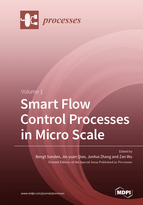Smart Flow Control Processes in Micro Scale
A special issue of Processes (ISSN 2227-9717). This special issue belongs to the section "Manufacturing Processes and Systems".
Deadline for manuscript submissions: closed (31 October 2019) | Viewed by 121788
Special Issue Editors
Interests: PEMFC; SOFC; batteries; hydrogen production and storage; renewable energy
Special Issues, Collections and Topics in MDPI journals
Interests: flow control; heat transfer; hydraulics; computational fluid dynamics
Special Issues, Collections and Topics in MDPI journals
Interests: flow control; aviation hydraulic; hydraulic robot
Special Issues, Collections and Topics in MDPI journals
Interests: boiling and condensation; heat transfer; microfluidics; surface modification
Special Issues, Collections and Topics in MDPI journals
Special Issue Information
Dear Potential Contributor,
With a large surface-to-volume ratio, microfluidic devices have witnessed a rapid development in recent years, and have reached many engineering applications successfully, such as organic synthesis, biomedical tests, and medicine delivery.
In a microfluidic device, fluid flow at a micro scale shows obvious different and unique flow characteristics compared with those in a common macro scale. Thus, focus on the flow behaviors at a micro scale has attracted many researchers, for the purpose of innovative heat and mass transfer enhancement.
A smart control process has been proposed for many years, while for the smart flow control, especially when “smart flow control” originates at the micro scale, it turns out that many new innovations and enabling technologies are possible. For instance, the precise flow rate in a micro-reactor means a high reaction efficiency. Similarly, for micro-mixers, a smart fluid control can improve the precise distribution of every constituent. Such systems are made up of micro-pumps, micro-channels, micro-valves, and so on.
In this Special Issue on “Smart Flow Control Processes at Micro Scale”, we welcome review articles and original research papers, fundamental or applied, theoretical, numerical, or experimental, on flow at a micro scale. Topics include, but are not limited to, the following:
- Flow control
- Flow chemistry
- Fluid flow
- Fluid power
- Heat transfer
- Lab-on-a-chip
- Mass transfer
- Microchannel
- Micromixer
- Micro pump
- Micro reactors
- Micro valve
- Microfluidics
- Micro process technology
- Multiphase flow
- Nanofluidics
- Nanofluids
- Process design
- Process control
- Smart control
Prof. Dr. Bengt Sunden
Dr. Jin-yuan Qian
Assoc. Prof. Dr. Junhui Zhang
Assoc. Prof. Dr. Zan Wu
Guest Editors
Manuscript Submission Information
Manuscripts should be submitted online at www.mdpi.com by registering and logging in to this website. Once you are registered, click here to go to the submission form. Manuscripts can be submitted until the deadline. All submissions that pass pre-check are peer-reviewed. Accepted papers will be published continuously in the journal (as soon as accepted) and will be listed together on the special issue website. Research articles, review articles as well as short communications are invited. For planned papers, a title and short abstract (about 100 words) can be sent to the Editorial Office for announcement on this website.
Submitted manuscripts should not have been published previously, nor be under consideration for publication elsewhere (except conference proceedings papers). All manuscripts are thoroughly refereed through a single-blind peer-review process. A guide for authors and other relevant information for submission of manuscripts is available on the Instructions for Authors page. Processes is an international peer-reviewed open access monthly journal published by MDPI.
Please visit the Instructions for Authors page before submitting a manuscript. The Article Processing Charge (APC) for publication in this open access journal is 2400 CHF (Swiss Francs). Submitted papers should be well formatted and use good English. Authors may use MDPI's English editing service prior to publication or during author revisions.









